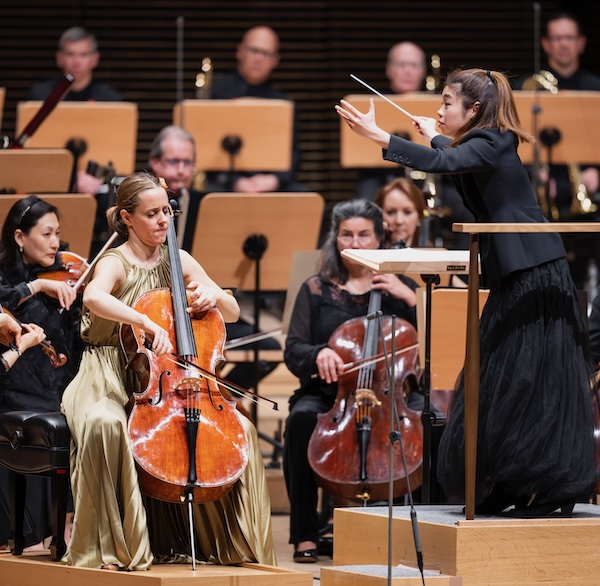Philharmonic treks from Indian country to the Sultan’s court in Chan’s mixed debut

From a Native American reaching for his “Hollywood moment” to a Russian who influenced a hundred movie scores, the New York Philharmonic celebrated the allure of the exotic in Thursday’s concert at Geffen Hall, vigorously conducted by Elim Chan in her Philharmonic debut.
Son of a dancer, the Chickasaw composer Jerod Impichchaachaaha’ Tate grew up in Oklahoma singing his tribe’s songs while becoming steeped in the famous ballets from The Rite of Spring to Appalachian Spring. A request from his mother for ballet music on Native American stories brought his classical training together with his Native identity, and the result was what he calls “a Romantic-dramatic composer” on Native themes who unabashedly likes the grand gesture, the “Hollywood moment.”
Bohuslav Martinů, born and raised in a church tower in a small Bohemian town, went to Paris in the early 1920s to get out from under his Germanic training and “learn how to be a Czech composer.” Diversity was more than a buzzword in a city that celebrated Surrealism, jazz, and the Ballets Russes.
Stravinsky, a star of that era and place, had been a pupil of Nikolai Rimsky-Korsakov, who found, if not his own identity, at least exotic inspiration in The Arabian Nights. His musical conjuring of a barbaric yet luxurious setting in the symphonic suite Scheherazade inspired not one but many Hollywood moments.
Tate’s piece for string orchestra Pisachi was commissioned by the string quartet ETHEL in 2023 as a response to archival photos of Southwest Indian country, part of the group’s Documerica project. The title is Chickasaw for “reveal,” which Tate says he wanted to do with Pueblo and Hopi music and cultures.
Thursday’s performance was the world premiere of the expanded, string-orchestra version of Pisachi. Violas led off the piece by softly intoning an Indian melody, non vibrato. Gradually, with conductor Chan’s constant encouragement, the piece’s symphonic character asserted itself, first in hushed tremolo and pizzicato episodes, then in deeply-bowed, stacked chords and soaring violins that evoked big-sky Americana.
Elsewhere in the piece, lashing downbows and syncopations put a rhythmic charge under the Indian theme, and a sudden crescendo brought it all to an end. The colorful music, and its composer coming onstage for a bow, were warmly but briefly applauded.
Martinů had certainly learned to be a Czech composer by 1931, when he composed his flavorful Cello Concerto No. 1. By 1955, he had subjected the piece’s orchestration to two overhauls, but Thursday’s performance of the last version was still too loud in the first movement, obscuring the brilliant but not robust playing of cellist Sol Gabetta, who was also making her Philharmonic debut. The contrast between the orchestra’s hushed accompaniments and its blatant, brass-driven tutti was simply too much.

The Andante moderato brought relief in the form of a dark chorale for winds, from which a long-breathed cello melody with Czech associations emerged. Chan urged the orchestra to a well-managed crescendo, culminating in a reflective cadenza-for-two, featuring soloist Gabetta and Philharmonic associate principal violist Rebecca Young.
An urgent snare drum propelled the agile soloist and orchestra in the fast, syncopated finale, which took a left turn into the soloist’s perky second theme with woodwind accompaniment. Gabetta’s attack and Chan’s lightening up brought an improved soloist-orchestra balance. The soloist’s freewheeling cadenza and dashing coda prompted prolonged applause, to which Gabetta responded with a vigorously bowed and plucked encore, “Flamenco” from Suite espagnole No. 1 by Rogelio Huguet y Tagel.
The musical world tour concluded in Arabia (or was it the Central Asian steppes?) with Scheherazade, a piece mostly lacking in actual Arabic scales or harmonies, but fragrant with quasi-oriental percussion and the sinuous violin melodies of Philharmonic concertmaster Frank Huang.
The performance of this familiar piece suffered from an apparent disconnect between conductor and orchestra, with Chan micro-performing every nuance of the music on the podium and the orchestra pretty much going its own way, delivering crescendos, climaxes and interludes on time, but without much sense of suspense or excitement.
After a rather loose rendering of the romantic Lento—which did, however, produce some nice sound chemistry between the harp and wind soloists—orchestra and conductor pulled together at last for the climactic “Sinbad’s Ship” episode and finale. Loud or soft, stuttering in brass or swirling in strings, a furious energy took over and swept all to the final crescendo, followed by the gentle epilogue, with Huang’s violin floating skyward.
The program will repeated 8 p.m. Friday and Saturday. nyphil.org







